At the hands of their teachers, trans students at TMU say they experience transphobia in many forms
Words by Abby Hughes
Visuals by Vanessa Kauk
CONTENT WARNING: This article contains mentions of transphobia
It was a stuffy June morning when Francis May* entered their psychology class for the first and last time. They entered the classroom and slipped into a desk in the back row. May signed up for the course in one of their first couple of years at the school and took it in the summer to ease up their course load during the fall and winter terms when they worked 30 hours a week.
May unpacked their computer and notebook and set up for class as others filed in. At nearly 10 minutes past the hour, the professor sailed through the door. As the teacher set his things down and started up the projector, he stated bluntly, “By the way, I don’t give trigger warnings,” May recalled.
That’s when May thought they were “in for something bad.” They were just beginning to figure out their gender identity and the professor’s jarring entry indicated this class likely wouldn’t be a comfortable learning environment for them. Despite their first impression, May says they reminded themselves to keep an open mind and hear where the professor was coming from—but that sentiment was short-lived. “It was harder and harder to empathize with him as he continued talking.”
The professor went on to explain his feelings on trigger warnings—how he thought being “triggered” meant having an “elevated nervous system.”
May remembered students looking around the room, confused and shocked. A few who disagreed raised their hand to refute, but were quickly shot down by the professor, who said they were misunderstanding him.
The Eyeopener reached out to the professor, who said while he doesn’t call them “trigger warnings,” he lets students know beforehand that they will be discussing controversial and hard topics in his class.
After a few rounds of student objections, the class gave up trying to change the professor’s mind, May said.
Given the course touched on gender and sexuality, his views bubbled to the surface in short order. He explained how he agreed with Jordan Peterson’s remarks—that being asked to use a person’s preferred pronouns is a violation of people’s freedoms. In the interview with The Eye, the professor stated that Peterson initially presented the issue poorly. But, he agrees with his sentiment that “we shouldn’t have compelled speech.” He said people shouldn’t be compelled by law to use certain pronouns, even though he chooses to respect people’s pronouns himself.
By this point, May’s blood was boiling. They’d been panickedly texting their partner throughout the class as they began to feel distressed by the content. Despite feeling angry and upset, May says they knew they weren’t in immediate danger as they didn’t think the professor could tell they were trans.
“I’m safe in the moment,” they remember thinking. “Because to him right now, I just look like a cis woman. So I’m just going to sit through this and then I need to leave.”
May used the next 45 minutes of class to look online for other courses to switch into. When they couldn’t find one, they tried to work out the mental math of how they’d fit the class into their fall or winter term, while continuing to work 30 hours weekly.
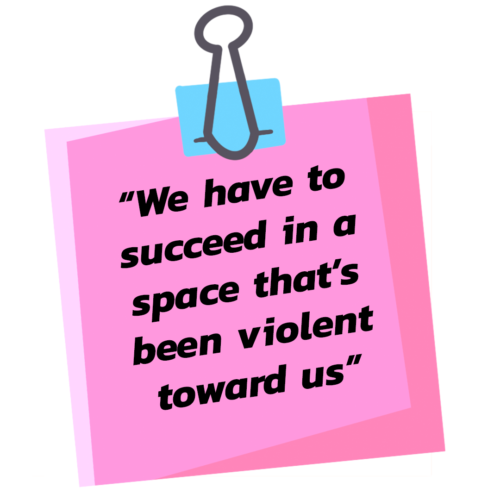
Finally, an hour and a half in when the professor called for a break, May scooped up their belongings and loudly told the person next to them that they were only leaving to get a drink of water. They suspected the professor might call them out if he knew they were trying to leave the class.
May isn’t sure if other students left too—they didn’t turn around to look behind them for fear the professor would see them leaving. They kept their eyes glued to the double doors that lead them out of the classroom. Only once they were in the stairwell and the classroom was out of sight did they take a moment to break down. Their heart rate still high, May sat on the empty yellow steps, focused on steadying their breath despite the panic in their chest.
At the hands of their teachers, trans students at TMU say they endure transphobia in many forms—the kind that’s hateful and the kind that’s born out of ignorance. And depending on the severity of the transphobia encountered, students face a range of aftereffects. Some feel extreme embarrassment while others, like May, feel they have no choice but to drop a class.
And while there are options for students to report these incidents, trans students say they barely use them. Despite the hurt, anger and humiliation that comes with transphobia, students are hesitant to report it for fear that the process might cause more harm than good. “The [reporting processes] offered are not always safe for students to pursue when they’ve already been harmed by someone in a position of power,” says May.
The university said it has multiple paths to remedy human rights issues like transphobia. They can go directly to their course union or department, they can seek advice and help from the ombudsperson, or they can go to Human Rights Services (HRS), which can pursue discussion-oriented or formal investigation processes. “At TMU, we are committed to equity, diversity and inclusion,” said president Mohamed Lachemi. He said the Centre for Excellence in Learning and Teaching offers a diversity of programs for faculty that focus on equity, including workshops about trans and non-binary student inclusion in the classroom.
The Trans Collective, one of six equity service centres at the Toronto Metropolitan Students’ Union (TMSU), can also provide support to students through any of these processes, too.
However, Ollie Coombs, the former director of the Trans Collective, says from July 2021 to October 2022—the year he worked there—only five students came to him with complaints about transphobia in the classroom.
After the disastrous first class, May made their way to the deserted course administrators office. Despite their sympathy for May’s situation, they couldn’t switch them into any other courses that term or issue a full refund. The administrator only advised May of the school’s Student Care office, which isn’t a primary office that hears complaints about professor conduct. Fearing retaliation and knowing nothing about the process, May had no interest in that option. With a feeling of hopelessness, they dropped the course.
From 2016 to 2018, the school’s HRS office pursued 240 human rights complaints, according to a report released by the department. Only six of these cases were related to gender identity. According to the school, they’re preparing to release 2021-22 complaint numbers shortly, but say this data shows reporting of “very few cases involving transphobia.”
Many trans students say they simply aren’t aware of the options available to remedy their transphobic experience. Despite promotional materials on billboards around campus that advertise the ombuds office, the Trans Collective’s posting on social media or HRS’ online Human Rights 101 module available to all students, trans students say they haven’t been made aware of where to turn in the face of transphobia at school. Others say they’re simply doubtful that the process would help them—as they’d have to retell their story, confront the professor, or in a worst case scenario, face retaliation from an educator.
Brea Hutchinson, a trans and feminist advocate and the director of operations at the Women’s Legal Education and Action Fund, says the onus to report—and transphobia in university classrooms generally—add another layer of difficulty to higher education.
“Not only do we have to go through everything else, all the hardships (of university), we also have to succeed in a space that’s been violent toward us,” she says.

oombs, who is also a fourth-year film student, takes the time to email his professors at the start of each term to make sure they’re aware of his pronouns. But too often, that email gets lost in the fold or otherwise forgotten. He gets misgendered a lot and professors don’t always take corrections with grace.
One time in his second year, Coombs remembers a professor misgendering him at the beginning of class while going over the day’s agenda. Coombs’ friend, a usually quiet girl, kindly reminded the professor which pronouns he used. Rather than being apologetic, the professor became defensive, saying pronouns are difficult for him as English isn’t his first language. He urged the class to be understanding of him, all without correcting himself or apologizing.
At that moment, 25 heads turned to focus on Coombs and his friend in the second row. He could feel their eyes burning on the back of his already-hot neck, wishing in that moment he could just fade away.
The room was palpable with a “silent kind of ‘Ah fuck this is so awkward,’” says Coombs. He sat through the rest of the class feeling terrible.
Coombs finds himself in a class with that same professor this term—only this time around, he doesn’t raise his hand to speak. “We’ve already been through the gamut. So I would rather just not participate with that professor than relive that experience,” he says.
There are overt forms of discrimination at TMU, Coombs adds, as well as small reminders that some profs just don’t understand the needs of trans people—like this instance of misgendering. And though the latter seems less severe, it’s still a boundary to education for trans students, he says.
Mary Breunig is a professor at California State University, Sacramento, with expertise in experiential learning and social justice in education. Breunig does what she calls a “hand slap” activity with her students. They pair up and one person has to answer simple math questions with their hands out in the air in front of them. If they don’t answer fast enough, their partner is allowed to slap their hands.
Most students seize up at the fear of getting slapped, making them freeze and not answer the questions quick enough. This, says Breunig, is likely similar to what the trans student experience is like in the classroom. “It’s counterproductive to learning if you’re expending that much energy just in the emotional labour of being seen for who you are,” she says.
Coombs says the reason few people complain about transphobia is twofold—in part, trans students have developed their own ways of coping with transphobia because it comes up so often in their lives. Others expect there’s little the school can do to bring change, so they choose not to amplify and re-live their pain by reporting it.
According to 2019 data from the Government of Canada on the experiences of post-secondary students with gender, gender identity or sexual orientation-based discrimination, Coombs is right.
The report stated that very few students—seven per cent of women and five per cent of men—reached out for help from their school when dealing with gender and sexuality-related discrimination. The report included trans students, though gendered their results.
Sixty-five per cent of the respondents said they didn’t report the incident because they didn’t think it was serious enough. Of those who did complain, 11 per cent said they didn’t think the school would take it seriously and 10 per cent of respondents felt embarrassed or ashamed of the incident.
Despite the low reporting numbers, Coombs did what he could for those who came into his office after experiencing transphobia. Students are greeted more often than not by an open door to the Collective’s office on the second floor of the Student Campus Centre (SCC). The small room boasts two sleek, simple couches, an armchair and a desk in the far corner of the room. Promotional materials from past events hang from multi-coloured push pins on the two big bulletin boards in the room. Bins of buttons and stacks of educational pamphlets on trans healthcare, among other subjects, lay in wait for curious students to pick up. It’s a small-but-quaint and quiet space that Trans Collective members like Coombs have tried to make feel safe.
While the Trans Collective can’t carry out resolution processes on their own, they can advise the student of where to go. If students want to further their complaint, Coombs advises them to first talk to the department head or their course union, the ombudsperson or HRS. He added that each instance is tailored to the individual experience and what they want out of it. If talking to their department head isn’t something they want to do out of fear, then the Trans Collective can reach out and make that connection.
The approach with departments or course unions isn’t formal, but it is a way to discuss problems with higher-ups in the hope that they will be able to make change.
The Office of the Ombudsperson is an independent body from the school that also hears the student’s concern and then helps facilitate conversations with course unions and department heads. The ombuds office mostly hears complaints about academic issues, according to ombudsperson Maureen Helt. However, the office has heard only a handful of complaints pertaining to transphobia in the past year. Her office refers students to Human Rights Services in cases where the university’s Discrimination and Harassment Policy (DHP) has been violated.
Helt, acknowledges that students haven’t always had the best experiences with these reporting processes. “There is a hesitation to actually take any type of action because in the past, historically, they have found that when they do speak up, nothing happens,” says Helt.

ne evening, Sophie Teal* got a message from her friend in her computer science program, alerting their Discord chat to an alarming discovery.
“So uh has anyone seen the prof’s Twitter?,” messaged the friend, along with two screenshots of transphobic tweets that had been retweeted by their teacher. One was supportive of transphobic comments by J.K. Rowling, the author of the Harry Potter series who’s legacy would later come to be clouded by her transphobia and another was a news article in which a group of doctors in the U.S. objected to performing gender transition procedures.
The Eye reached out to this professor. He responded saying that these are his personal, private views and that he is not transphobic. He said, however, he is concerned with the erosion of women-only spaces and the sex reassignment industry exploiting children.
Teal’s chest swelled with a sinking feeling—one she gets when she hears something hurtful. She did some digging of her own and found more and more controversial content on the Twitter page. She felt sadness—how could he get away with this, especially since his Twitter was so publicly available?
After finding the tweets, Teal had messaged her year’s representative from the Computer Science Course Union (CSCU) on Discord about the professor. She passed along the screenshots of the retweets and the representative promised to bring up the issue to the CSCU. Teal then found out the issue with that professor had been made known to the course union a few years prior.
Teal says the representative tried hard to help her but “just couldn’t get very far.”
And on top of not knowing about the ombuds office’s or HRS’ complaint processes, Teal didn’t care to try and revive the issue. “I don’t feel like trying anymore, to be honest,” she says. “I have too many problems in my own life to deal with this one too.”
Hutchinson says putting the burden on trans students to report through an arduous procedure isn’t fair. Those with power, like faculty and university bodies themselves, should wear the burden of making classrooms safe, not trans students, she adds.
“Students, who have the least amount of institutional and interpersonal power in the university, are the ones who are most responsible to create a more just classroom. It’s completely backwards.”
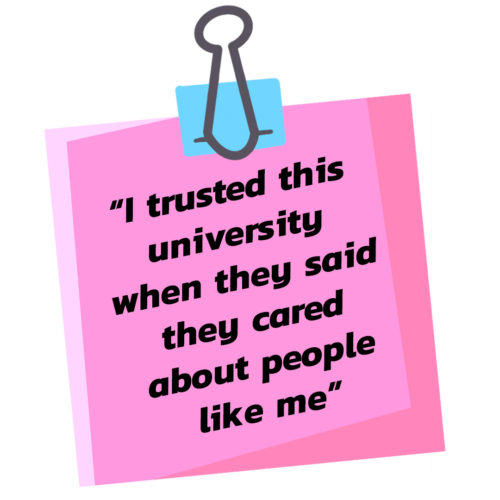
Helt says she’s aware some students see the ombuds’ reporting process as something of a burden when students are not aware of who to contact to make their complaint or express their concern. When students come to her, she makes them aware of the potential length and stress that progressing it might have on them. “A student has to decide for themselves what they want to do. And I wouldn’t push for them to do it (or) discourage them from going through the process,” says Helt.
When Teal’s alarm went off at 5 a.m. the morning of her exam with that same professor, she climbed out of bed—the world still pitch dark outside—and pulled on a pair of jeans and a hoodie.
As she applied a thin layer of foundation, eyeshadow and mascara, Teal tried to think about the content she’d be tested on in just a few hours. But the thought of having to see her professor in-person for the first time popped intrusively into the forefront of her thoughts.
What if I don’t pass in front of him? Will he say transphobic things to my face?
The course had been delivered almost entirely online thus far, given the 2022 winter term was made virtual due to rising COVID-19 cases. Entering the George Vari Engineering Building for her exam after finding the professor’s Twitter, Teal cast her gaze on the ground to avoid making eye contact with anyone. She focused on some breathing exercises that her therapist had armed her with, but it was useless—she was overwhelmed with the stress of the exam, which was worth more than 50 per cent of the final grade and the potential of seeing her professor.
Upon entering the exam room, Teal didn’t have any time to see where her professor was. The teaching assistants seemed to not know what was happening and the man helping with IT was yelling to get people’s attention.
Only when the assistant professor told the class the first professor wasn’t in the building two hours into the exam, did she realize he didn’t show up. Teal let out a sigh of relief.
In hindsight, she says she’s discouraged at the school’s lack of action when it comes to dealing with transphobic professors. “I trusted this university when they said they cared about people like me.”
In a statement to The Eye, the university said, “Toronto Metropolitan University (TMU) is committed to fostering a collegial study and work climate that is free of discrimination and harassment and one in which all individuals are treated with respect and dignity.” They further added that “the university has policies and processes in place, including the DHP Policy, to address and prevent concerns relating to discrimination and further its commitment to fostering a welcoming, supportive, and respectful learning, teaching, research, and work environment for all.”

ay returned to the same course in the regular school year, this time taught by a different professor. This second professor made the course accessible and comfortable, says May. Their required readings alone touched on sex and disability, perceptions of trans identities, affirmations of trans identities during sex and more—none of which they say were on the syllabus in the first class.
May says they don’t think any space is ever 100 per cent safe, but says centres by and for queer students, like the TMSU’s equity centres and classrooms with queer professors, are some of the safest on campus. They add that the recent change in allowing students to use their preferred name in the school’s systems is very positive, but more still needs to be done in order to protect trans students at TMU.
Revising the Discrimination and Harassment Policy to more difinitively say anti-trans sentiment is a violation of those students’ rights on campus would also be a positive change, according to May.
Coombs, too, would like to see policies revised, as well as a dedicated gender and sexuality office on campus. Seeing as the University of Toronto already has such an office, he hopes TMU might follow in their footsteps. Coombs says this would take some weight off of the Trans Collective’s shoulders, which in the absence of such an administrative office, has stepped in to support all trans TMU community members. The Collective provides support on issues and policy decisions, rather than just simply building community among trans students.
“It’s great that the Trans Collective exists, but it is not enough. [We can’t] just rely on this one office, in a little tiny room in the SCC, to handle everything perfectly.”
*The names have been changed to protect source’s safety and privacy.


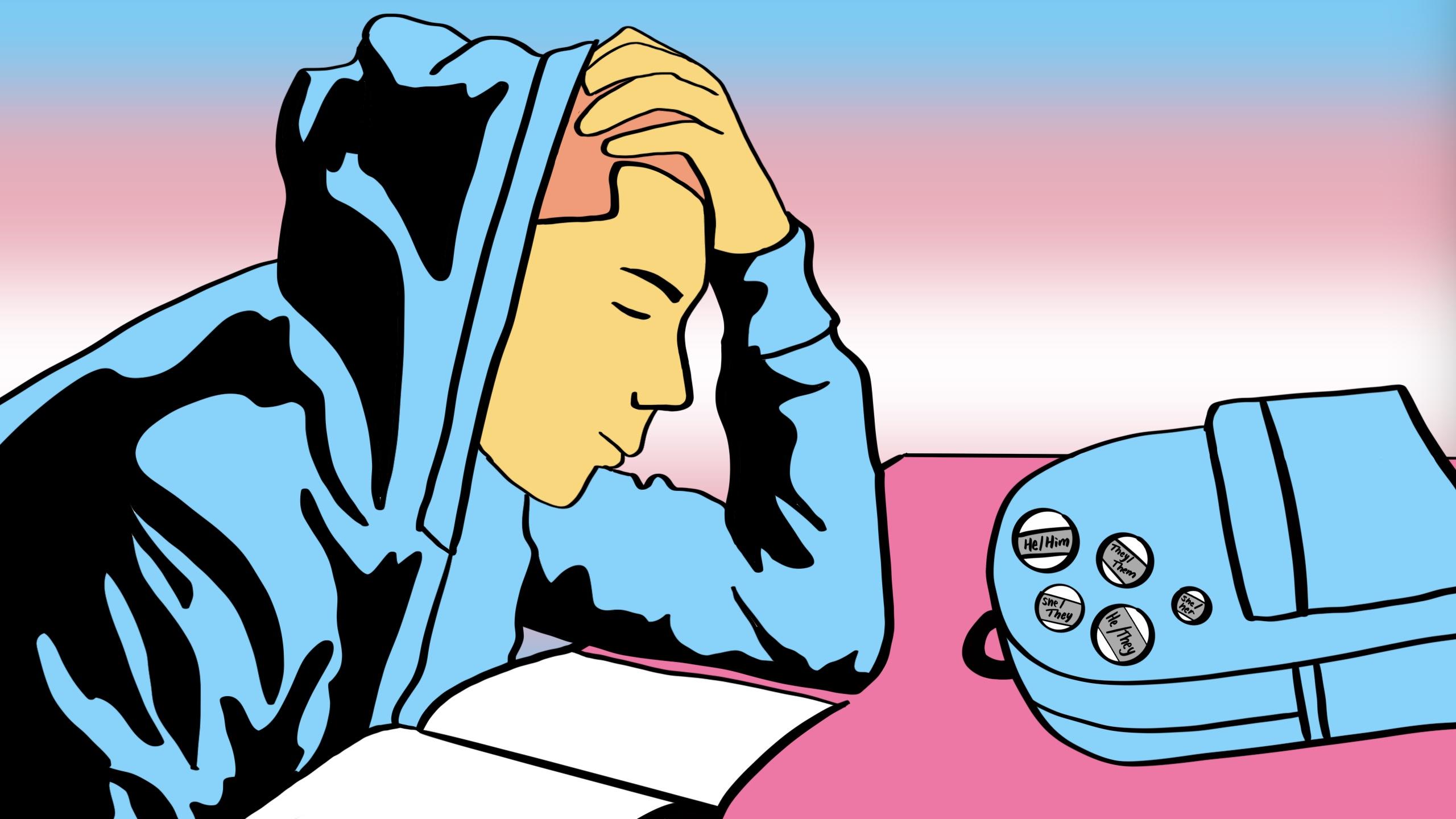



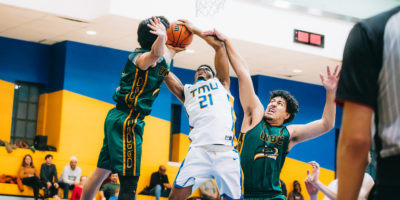
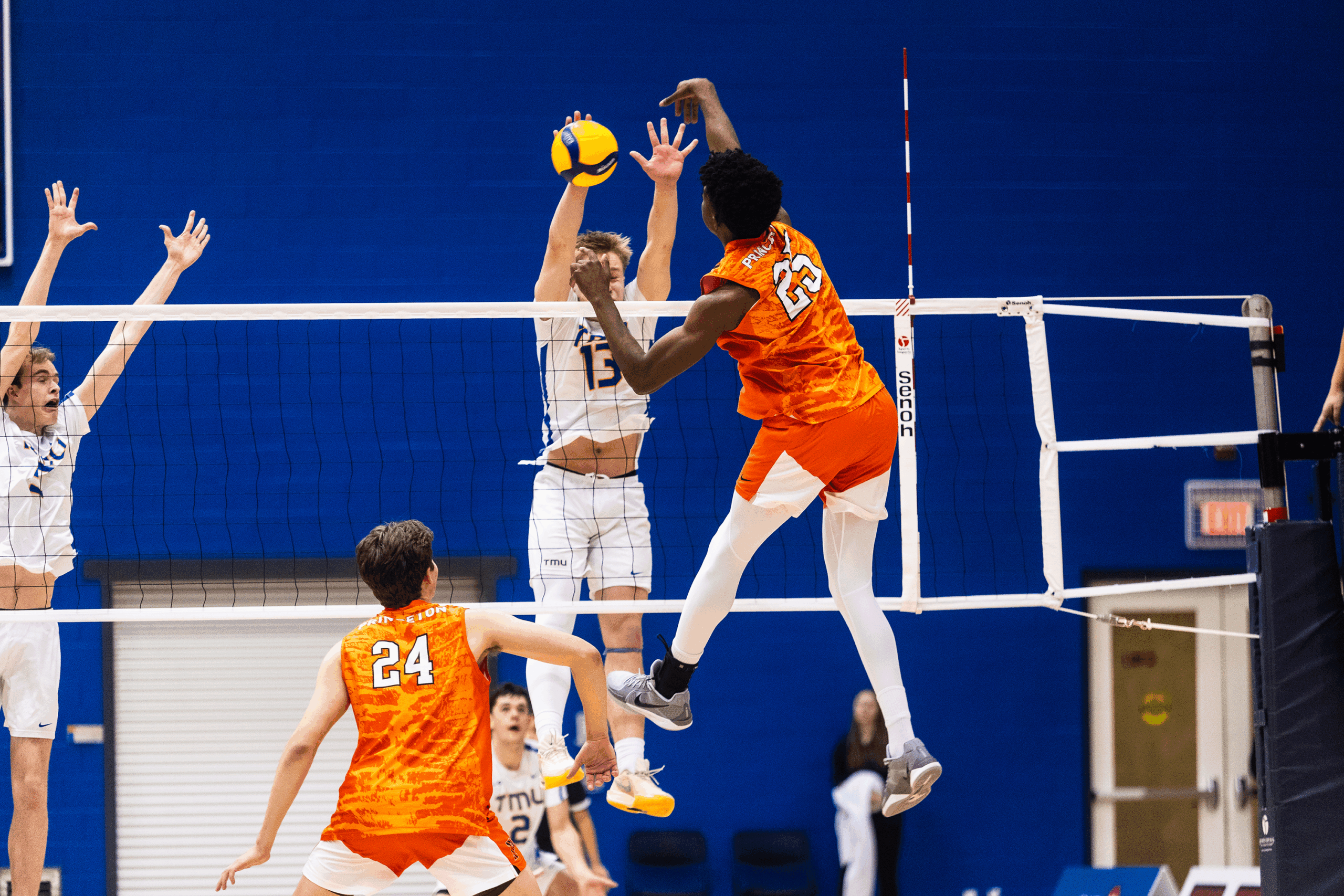



Leave a Reply